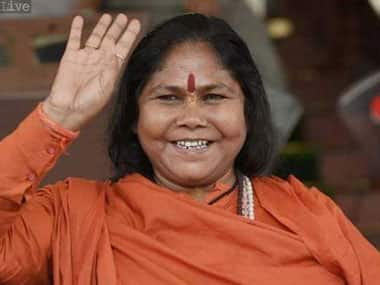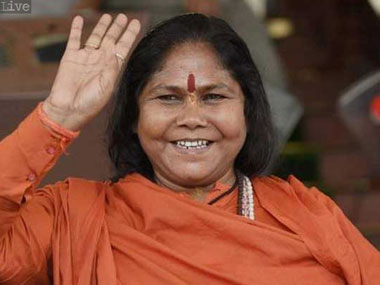After the BJP and Narendra Modi’s rampaging march in the serial elections, the Opposition has fallen back on its time-tested tactics of resorting to a parliamentary logjam, this time over junior minister Sadhvi Niranjan Jyoti’s highly objectionable statement of ‘Ramzade vs haramzade’ that springs from the ‘we-they’ syndrome that is seen to define the ideology of the RSS and its affiliates as well as of other right wing fundamentalist forces. The justifiable outcry over Jyoti’s statement — to which the Uber cab rape case has been added — is also meant to serve three other objectives. The first of course is to prove to the government, specially when it does not have a majority in the Rajya Sabha, that it cannot wish away the opposition even if there is no officially recognizable leader of opposition in Lok Sabha and its rivals are a distant threat. The BJP has a comfortable majority of its own in the Lok Sabha and with its allies can ride rough shod on any issue. With a 24-seat difference between the 45-member BJP and the 69-member Congress in the Rajya Sabha, the government has to depend on the opposition’s cooperation if it wants to pass key legislations. That is a weapon that the opposition has for another couple of years until the composition of the House changes with the changing complexion of the state assemblies. It is for this reason that the Rajya Sabha has remained paralysed for most of last week while the Lok Sabha continues to function despite the protests, walkouts and black bands of the opposition MPs who draw sustenance from the agitations of their peers in the Upper House. [caption id=“attachment_1839395” align=“alignleft” width=“380” class=" “]  Junior minister Sadhvi Niranjan Jyoti. CNN IBN image[/caption] Members were not satisfied with Jyoti’s ‘regret’ or the Prime Minister informing the House that he has ticked off his colleague who should now be ‘forgiven’. But by referring to her social background he ended up infuriating his rivals who saw it as another ploy to fuel sectarian passions. Not surprisingly, the opposition insisted on her removal and the government rejected it outright. But in a half-way measure to break the stalemate and underline that they were not being unreasonable, the opposition proposed a House resolution which without naming anyone condemns hate speeches. The government has not shown any interest in this so far as it believes that resolutions are ‘issue centric’ and ‘not individual centric’. Even the Trinamool would be wary of such a resolution since it would be seen as a reflection of the House frowning on its Chief Minister Mamata Banerjee who hit the headlines for the wrong reasons with her controversial ‘bamboo’ remarks. Both sides have been waiting for the other to blink first. The stakes are high for the ruling party which wants to usher the reforms process, including the passage of bills relating to insurance, GST, real estate regulator and coal block auctions during the remainder of the turbulent session. It does not have the luxury of waiting till a popular backlash hits the opposition or the opposition tires itself out with its protests. As a ruling party which is expected to be sensitive to the concerns of its rivals in Parliament, the onus of running the House is as much on it as it is on the opposition and it will have to look for a mutually acceptable formula to break the stalemate. The opposition, on its part, knows that it cannot drag on with the issue without being dubbed obstructionist and irresponsible and believes it has tried to be sensible by proposing a joint resolution that refrains from mentioning any names while condemning hate speeches by MPs and ministers. But if the first objective of the nine opposition parties ranging from the Congress to the SP, JD-U, Trinamool and the Left was to haul up the government for the sins of its minister, their second objective was directed at themselves. They seemed out to prove that despite their mauling in the national and state elections or the challenges they are grappling with, they still retain some of their fighting spirit. This is particularly true of the Congress and the Left which are trying to boost their own morale and that of their despondent workers by signaling that they can live up to their role as an effective and viable opposition. In contrast to this, the diatribe against the Centre by the Trinamool Congress–which did well both in the state and general elections–is intended to offset the political impact of the Saradha chit fund scam and the Burdwan blasts on the image of its leader and West Bengal chief minister Mamata Banerjee. The third objective is aimed at underlining that if their individual protests do not count a united opposition can be more than a match for the government and can put it on the defensive even if the BJP enjoys a majority in the Lok Sabha and Modi a honeymoon with the people. But this can happen so long as they stay united which appears to be an unlikely scenario. While any government — and the BJP are no exception — would try to drive a wedge between these disparate forces, the coming together of many of these parties is itself riven with contradictions. Take this, for example: While the nine opposition parties in the Rajya Sabha have signed a joint statement to demand a resolution censuring Jyoti, the same parties in the Lok Sabha have failed to come up with something similar. Also, there are divisions within the protesting parties themselves. As the CPI-M’s West Bengal unit was upset with its parliamentary unit being seen alongside the Trinamool in battling the Modi government, the Left party decided not to join the black band protest of the opposition MPs of Lok Sabha. Further, a section of the SP, JD-U and the BSP is privately of the view that following Jyoti and the PM’s statements in Parliament, the matter should be put to rest. And the AIADMK and the BJD, to maintain their equidistance, have stayed away from the protests launched by the other parties. Given these differences, any unity is likely to be shortlived. But the agitated opposition MPs, who number over 100 in the Rajya Sabha, know that this is the best opportunity they have to put the government in the dock and are therefore exerting all their might in trying to force a joint resolution. It would, in their view, serve democracy by setting an example to those who dare to cross the red line again in their public discourse. The Modi government, on its part, has until now managed to stave off all attempts at arms twisting be it from the opposition or even its allies like the Shiv Sena in Maharashtra or the Akali Dal in Punjab. Can it afford to do so now, specially when it wants to push its legislative agenda through and run the risk of being branded obdurate and unresponsive? The big question is who will blink first.
After BJP and Modi’s rampaging march in elections, the Opposition has fallen back on its time-tested tactics of resorting to a Parliament logjam.
Advertisement
End of Article


)
)
)
)
)
)
)
)
)



